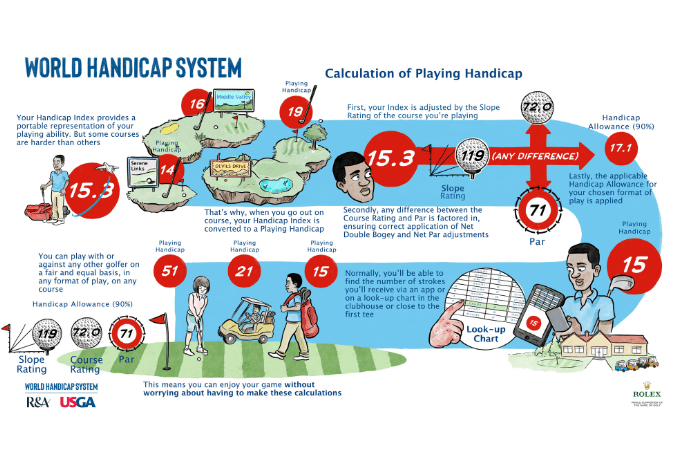Golf Handicap – Meaning, How it works And Do You Need One?

A step-by-step detailed guide to finding out about golf handicap. Find out what is USGA handicap index and what features affect the golf handicap calculation.
If you are new to golf or desire to play more competitively, understanding your golf handicap is key. It provides a baseline for measuring your progress and helps you set attainable goals.
Here, we explore all about golf handicap so that you can make the most out of your handicap the next time you hit the shots over the golf courses.
What is a golf handicap?
A handicap is defined as “a measure of a golfer’s potential playing ability based on their performance in past rounds of golf.” In other words, it’s a number that indicates how good (or bad) a golfer is relative to other golfers. Moreover, it is also a standard barometer used to compare golfers with different levels of skills from across the world.
Handicaps are used in both – match play and stroke play competitions. It helps to level the playing field and make the outcome more dependent on the skill than the raw power.
The handicap system, which is used globally, is calculated based on the golfer’s best-performing rounds. Men typically have handicaps between 0 and 28, while women typically have handicaps between 0 and 36. Golfers can monitor their development, establish goals, and enhance their overall performance with the aid of handicaps.
Types of Handicaps
There are two types of golf handicaps – Low Handicap and High Handicap
1) A Low Golf Handicap
A low handicap (also referred to as scratch golfer) in golf normally varies from 1 to 10. Golfers with a low handicap typically shot near to the par, with one or two bad holes per round. It’s rare for a low-handicapper to score above 80 in a single round. Keeping your handicap low takes a lot of effort, skill, and consistency in your game.
2) A High Golf Handicap
In golf, a high handicap refers to a player whose score index is 20 or higher, typically scoring in the mid-’90s or beyond 100. This is the most common category of golfers, with over 50% of male golfers and 80% of female golfers falling under this category. High handicappers tend to struggle with consistency and accuracy and often make mistakes that result in higher scores. Players with high handicaps are often referred to as “handicap hackers” or “high-handicappers.
Therefore, let’s understand the features of Handicapping systems to know how they are used for calculating golf handicaps.
Features of handicapping systems
Most handicapping systems feature some combination of the following elements:

1. Scoring
This is arguably the most important element of any handicapping system. To calculate a player’s handicap, their scores must first be tabulated. These scores can come from actual rounds played or from practice sessions on the driving range or putting green. Moreover, the handicap would be more accurate if you have more data available.
Gross Score: It is the total number of strokes taken for a hole before actually accounting for a golfer’s handicap. This score is called the gross score for that hole.
Net Score: The number of strokes that are taken into consideration after subtraction of any handicap is called the net score.
2. Maximum Hole Scores
This is simply the maximum number of strokes that can be taken on any given hole without incurring penalty strokes (e.g., most courses have a Maximum Hole Score of 8).
3. Course Rating
This is a number that represents the difficulty of a course for scratch golfers (i.e., players with zero handicaps). In general, if the course rating is lower, it is easier to play. Most course ratings range from 68 to 74. Anything below 68 is considered easy, whereas anything above 74 is considered difficult.
Moreover, to calculate a rating, factors such as terrain, length of holes, and the number of water hazards are taken into account. Once these factors have been considered, the USGA (United States Golf Association) assigns each hole on the course a value between 1 and 18 (a typical 18-hole course will have four 1s, four 2s, etc.). These values are then added up to get the final course rating.
Note: Keep in mind that course ratings can change over time as courses are redesigned or updated in some way.
4. Slope Rating
This number measures the relative difficulty of a course for bogey golfers (i.e., players with 18 handicaps). In general, courses with high slope ratings are more difficult for bogey golfers than courses with low slope ratings. Most slope ratings range from 55 to 155, with anything below 55 being considered easy and anything above 155 being considered difficult. Therefore, a course of standard relative difficulty with a rating of 113.
5. Course handicaps
Course handicaps are used to adjust for the difficulty of the golf course being played. Moreover, a course handicap is the number of strokes above or below par that a golfer will likely score on a given course.
Course handicap = (handicap index x slope rating)/113 + (course rating — par)
6. Playing handicaps
A playing handicap, on the other hand, is the number of strokes above or below par that a golfer will likely score on any given course, taking into account factors such as course difficulty, weather conditions, and elevation changes. In other words, playing handicaps are used to adjust for the difference in skill level between two golfers.
Playing Handicap = Course Handicap x handicap allowance
For example, if golfer A has a course handicap of 10 and golfer B has a course handicap of 20, then golfer A would get a 10-stroke head start in a matchplay competition.
7. Handicap Allowance
A handicap allowance is applied to the course handicap as the final step while calculating a player’s playing handicap.
8. Handicap Differentials
This number represents how many strokes above or below par a player typically scores on any given hole. It is used to calculate both playing and practice handicaps.
How to calculate handicap differentials?
To calculate this number, subtract your Adjusted Gross Score from your Course Rating, then multiply that number by 113 and divide by slope rating.
Handicap differential = (adjusted score – course rating) x 113 /slope rating
Example: If your Adjusted Gross Score was 82 and your Course Rating was 72, your slope rating is 100, your Handicap Differential would be (82-72) x 113/100. Then, the average Handicap Differential is between 4 and 5 strokes per round of golf.”
Change the gross score into the adjusted total score to create a handicap calculation.
To find the maximum number (golf score) that can be obtained is mentioned in the table below:
| Course Handicap system | Maximum score (Golf Score) |
| 9 or less | Double bogey |
| 10-19 | 7 |
| 20-29 | 8 |
| 30-39 | 9 |
| 40 and above | 10 |
Golf Handicap Index Calculation: Steps and Systems
In golf, a handicap is a numerical value used to indicate a player’s skill level in comparison to others. It is calculated based on a player’s past performances in previous rounds, and it is used to level the playing field in competitive matches by adjusting the player’s score.
Here are the steps to calculate your golf handicap index:
- Select the best scores out of your 20 most recent scores.
- For each score, subtract the course rating from your score and then multiply the result by 113. After that, divide the obtained number by the slope rating of the course you played.
- Choose the lowest 10 handicap differentials of the 20 scores that you’ve decided to use.
- Average those 10 handicap differentials.
- Multiply the average by 0.96, and the result is your handicap index.
Different systems to calculate your golf handicap
There are a number of different methods to calculate your golf handicap, but they all have one goal: to produce a number that reflects a golfer’s potential playing ability as accurately as possible. The below-mentioned systems are the most commonly used systems for golf handicap calculation:
1. USGA Handicap System
The most common method for handicap calculation is the USGA Handicap System. This system uses a formula that takes into account a golfer’s scores, the difficulty of the courses being played, and the teeing ground used.
2. World Handicap System
Another common method for calculating handicaps is the World Handicap System (WHS). The WHS was introduced in 2020 and is now used by over 60 countries around the world. The WHS uses a different formula than the USGA Handicap System, but it produces similar results.

3. Official Golf Handicaps
To establish an official golf handicap, you will need to submit scores from at least 5 rounds of golf to your local golf club or governing body. These scores must be from courses with valid USGA course ratings and slope ratings. Once you have submitted your scores, your handicap index will be calculated using one of the methods mentioned above.
Note: To obtain and maintain an official USGA Handicap Index, you must be a member of a golf club that belongs to a state or regional golf association that is licensed by the USGA to issue and monitor official handicaps for its members.
USGA handicap index
A USGA Handicap Index or golf handicap index is used to indicate a player’s potential scoring ability on any golf course from any set of tees and consists of two parts: a Course Handicap and a Slope Rating.
For example, if you have a 10.2 USGA Handicap Index, your Course Handicap would be 10 strokes when playing with a Slope Rating 113 course.
A USGA Handicap Index is calculated using the best 10 of your most recent 20 scores and using the Course Rating and Slope Rating of the tees you played. It is expressed as a number to one decimal place (for example, 4.3, 5.8, etc.) and rounds to the nearest integer (for example, if your calculated index was 4.68, it would be rounded to 4.7). This value will increase or decrease as you post more qualifying scores.
As of January 2020 new rule, you have to submit three 18-hole scores to obtain the Handicap Index. It can be made with a combination of 9-hole and 18-hole rounds. The handicap index will be revised at the beginning and middle of every month (1st and 15th).
This change mentions that you submit only three 18-hole scores. As long as you update the third 18-hole score before midnight, your handicap will be amended daily.
Moreover, you can refer to the official website of the USGA’s Golf Handicap Information Network (GHIN) for golfer management and score posting products. It is one of the largest handicap management tools in the world.
Steps to improve your golf handicap
If you’re serious about improving your golf handicap, here are some useful tips to get you started:
- Improve your swing: Practicing early and often can help improve your swing in golf.
- Ensure your equipment is ideal: Using fitted equipment that suits your game is important to avoid injuries and improve your performance.
- Keep pushing yourself: Setting new records every time you play can help you track your progress and motivate you to improve your game.
- Visualization: Many top golfers use a mental technique called visualization to picture the whole shot-taking process in their minds, which can help improve their performance.
- Maintaining Healthy Fitness Levels: Doing physical activities such as hiking, swimming, basic gym workouts, and maintaining a balanced and healthy diet is essential to stay fit and perform well in golf.
- Play solo rounds independently: While golf is a great game for socializing, visiting different courses on your own and completing a round without distractions can improve your concentration and help you get serious about improving your handicap.
What is a good (or) bad handicap number?
A golfer’s skill level is determined in the game by their handicap number.
The golfer with the lowest handicap is the best, while the player with the highest handicap is the worst.
A golfer with a handicap of 1 is considered extremely skilled, but a golfer with a handicap of 40 is not. Golfers frequently strive for excellence and the lowest attainable handicap in order to demonstrate their ability level.
Conclusion
A golf handicap is calculated using the best 10 of your most recent 20 scores and adjusting those scores using the Course Rating and Slope Rating of the tees you played. Most importantly, it is portable from one golf course to another so that whether you’re playing at home or away, in favorable or unfavorable conditions, you’ll always have an index that reflects your potential scoring ability.








